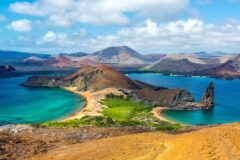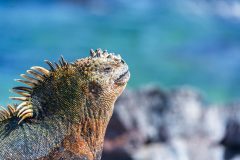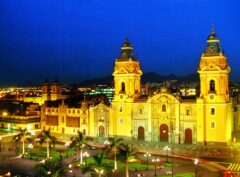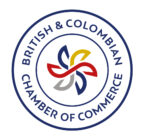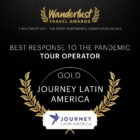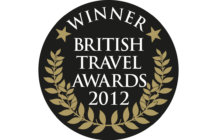Private Journeys
Self-drive Cuba: Explore the east
13 days from £2,240pp
(based on two people sharing & excluding flights)
Itinerary
 Map
Map
Day 1
Transfer from the airport to your hotel in Havana.
Your accommodation is in the very heart of historic Havana just a quick stroll from the city’s principal squares.

Stay at -
Madero Bed and Breakfast
Day 2
Guided walking tour of Old Havana. Collect hire car.
Your introduction to the city is a guided walking tour of Old Havana. The streets of La Habana Vieja were declared a UNESCO World Heritage Site in 1982, and the subsequent restoration of this part of town has transformed it into arguably Latin America’s finest colonial quarter, in marked contrast to the rambling, potholed streets and crumbling façades around it.
Stroll along the cobbles, between grand, pastel-hued mansions and bustling street life. Music seeps out of every doorway and the narrow streets are clogged with classic 1950s American cars, which you will have the option of hopping into and cruising down the Malecón. You’ll have trouble keeping your camera by your side as iconic images flash before you round each and every corner.
Collect your hire car, a Seat Althea or equivalent.

Stay at -
Madero Bed and Breakfast
Day 3
Drive to Cienfuegos port, and on to colonial Trinidad.
Drive on to the city of Trinidad through the central heartland of Cuba – a transition between the pre-Revolutionary prosperous western plantations and the cattle pasture of the poorer east. Maybe stop off in the elegant city of Cienfuegos, an important port town founded by French settlers from Louisiana in 1819. Its French founders left their mark in broad neoclassical boulevards, art deco façades and blond inhabitants but there’s also a strong Afro-Caribbean presence.
This is a seafaring city with salt in the air; it’s the world’s primary sugar port. The ambience and architectural style is distinct from that of the rest of the island. Continue by car to Trinidad, declared a UNESCO World Heritage Site in 1988. Its popularity has not affected its colonial charm and unhurried atmosphere. You’ll be staying in a family home here for 2 nights.
There’s a feast of terracotta-tiled roofs, cobbled streets and pastel-coloured buildings. Founded in 1514, the town was originally used as a base for expeditions into the ‘New World’; its squares and churches date from the 18th and 19th centuries. The town has hardly changed in a century, no suburbs creep out from its historic centre and no high-rise buildings obscure the view to the sea. Home-grown talent fills the squares and music venues in the evenings, when the town comes alive with dancing and the sound of salsa. Evening entertainment continues into the early hours with dancing and music each night.

Stay at -
Iberostar Grand Hotel – Trinidad
Day 4
Walking tour of Trinidad and optional trips out into surrounding countryside.
On your guided tour you will wander through Trinidad’s cobbled streets and elegantly crumbling town houses which lead to vibrant plazas frequently filled with music and salsa dancing. As you visit the Plaza Mayor and Museo Romántico, you’ll be introduced to the history of this UNESCO World Heritage Site, which seems barely touched by the modern world. Stop at an authentic Cuban bar to sample a traditional cocktail, before heading off to one of Trinidad’s ceramics workshops.
Before or after the tour you may venture into the surrounding countryside, the Valle de los Ingenios (valley of sugar mills). In the 18th and 19th centuries, this region was one of the wealthiest as a result of its participation in the sugar boom. The Manaca-Iznaga tower has some of the best views in Cuba. From there, the plantation owner kept a watchful eye on the slaves working in the fields below. Or you might drive up to Topes de Collantes National Park. The park is in the Escambray mountains which are a backdrop to Trinidad and have an exquisite landscape of forests, waterfalls, deep valleys and lakes, perfect for car touring or hiking along visible trails.

Stay at -
Iberostar Grand Hotel – Trinidad
Day 5
Drive to Camagüey via Sancti Spíritus.
Drive to Sancti Spíritus. This city sits right slap bang in the centre of Cuba. It was one of the original 7 Cuban cities founded by the Spanish in 1514. Its colonial origins are evident in its buildings and layout, although it is not as exquisite and well preserved as the Trinidad to the south, which as a result attracts more visitors. Its neglect by governments through the ages in certain areas have led to many of the buildings taking on an authentic faded charm.
Highlights include the green-towered Parroquial Mayor, the country’s oldest (founded in the early 16th century). It’s close to town’s main square. Another top attraction in this central area is the Museo de Arte Colonial (Colonial Art Museum), occupying one of Sancti Spíritus’s loveliest colonial homes. The luxurious mansion belonged to one of one of Cuba’s old aristocratic families. Following their flight from Cuba after the Castro Revolution, it became the property of the state in 1961. Most of what you see inside, from furniture to paintings, is original. The town also hosts one of Cuba’s older river bridges. Graced with five arches, this short bridge was constructed in 1815 from clay bricks, designed for pedestrians and carriages during colonial times, and it remains closed to modern traffic.
Continue to Camagüey.
Stay at -
Hotel Camino de Hierro
Day 6
Guided walking tour of Camagüey.
Founded by Spanish conquistadors in the 16th century, the city, with its winding streets, is in marked contrast to the grid system which characterises the majority of Cuban towns. Stately colonial houses facing onto streets; huge windows protected by wrought-iron grilles; lush green gardens tucked behind the walls. It’s a vibrant place bursting with culture – national poet Nicolás Guillén was born here and the Camagüey Ballet is internationally renowned. On Saturday nights, there is a lively street party along its main thoroughfare, Avenida República.
On your guided walking tour you will discover its irregular, intricate street network while admiring public and private buildings of great colonial architectural beauty, including Plaza San Juan de Dios.

Stay at -
Hotel Camino de Hierro
Day 7
Drive from Camaguey to Santiago de Cuba
Take the Carratera Central to Autopista Nacional (A1). We recommend a short stop at Bayamo, a gem featuring pastel painted houses and marking the spot where the mountains of the Sierra Maestra begin. (If you are interested in trekking we can arrange an additional night or two so you can visit the Comandancia de la Plata. This was Fidel’s mountain hideout, where his revolutionary strategy was organised). Alternatively, just have a leisurely stroll around the streets and square before continuing via Juiguani to Santiago de Cuba. With a stop planned, leave early and allow a full day.
Santiago de Cuba, the island’s most Caribbean city and a melting pot of Haitian, African and Spanish influences, reflected in both its architecture and people. Cuba’s second largest metropolis sits in a valley surrounded by mountains huddled around a natural harbour.

Stay at -
Hotel Casa Granda
Day 8
Guided walking tour of Santiago.
Despite being a bustling hive of activity, Santiago retains an intimate and friendly air, more associated with a smaller provincial city. What’s more, the city is jam-packed with culture and tradition, from the deep-rooted African religion of Santería to its conveyor belt of great contemporary musicians.
Also known as the Heroic City, Santiago played an important role at the beginning of the wars for independence. This guided tour takes you to the major places of interest, including the Moncada Barracks, famed for the unsuccessful pre-revolution attack by a handful of rebels led by Castro. This failed attack nevertheless was the springboard which launched the revolution. Cementerio Santa Ifigenia, Barrita de Ron Caney, the Casa del Habano and the San Pedro de la Roca colonial fortress. You’ll have a seafood lunch at the quay.
Stay at -
Hotel Casa Granda
Day 9
Drive from Santiago to Gibara.
Head north cross country towards the Caribbean coast. You will arrive at the region’s major town Holguin ( 3-4 hours) from where it’s a drive of a further hour to Gibara. Holguin is Cuba’s fourth largest metropolis but for visitors is primarily a transit point for those heading to the island’s increasingly popular north-east coast beaches such as the resort of Guardalavaca, 50km away. Despite its size, Holguín is an easy-going and friendly city. The centre is quite dilapidated but its several parks and squares are dominated by statues to national heroes.
The off-the-beaten-track community Gibara, a little port situated on a bay on the scalloped north east coast has been spruced up after earthquake damage, is delightful and worth the detour. The fishing port is situated in rugged, hilly landscape dotted with royal palms and interspersed with sugar cane plantations in the valleys.

Stay at -
Hotel Ordono
Day 10
At leisure in Gibara.
The crinkly coastline, with secret coves which once sheltered buccaneers, is gradually being opened up to tourism, but the port Gibara retains its off-beat, remote ambiance. The town is named after the lumpy hill which composes its backdrop. There’s a grand view of the town from the ruined fort El Cuartelon. The main square, dominated by a 19th century cathedral built in eclectic mix of styles, is shaded by African oak trees imported from Angola in the 1970s. The calm little streets and waterside malecón are lined with sedate old houses with porches and stained glass windows, gradually being done up.
You may decide to drive or walk further afield to visit the Cavernas de Panadernos, a chain of underground limestone caves – you are advised to take a local guide if planning to enter them; you can hire one in town. The presence of fluttering bats ads to the eerie atmosphere. Alternatively drive along the craggy coast to one of the gorgeous beaches, many of which now feature hotels and facilities. Guardalavaca is the best established of these.

Stay at -
Hotel Ordono
Day 11
Drive back west to Santa Clara.
Head back to the Carretera Central via Holguin and westward to Santa Clara. (The northern route – the Circuito Norte – is not currently recommended, as the road surface is poor in places and facilities such as petrol stations and eateries are rudimentary). This is a very long day so we suggest an early departure, allowing a good couple of hours during daylight for stops and lunch.

Stay at -
Hotel Central – Santa Clara
Day 12
Drive from Santa Clara back to Havana.
We suggest you take the route A1 straight back to Havana as this will allow you time to look around Santa Clara before you leave. Santa Clara, founded on agriculture and mining, gained importance when a railway was built to connect the city with Havana. This track provided for one of the most momentous events in Castro’s revolutionary campaign: the hijacking of a train carrying government guns and soldiers. A few of the carriages are on display in what is this lively university city’s most important monument.
If you enjoy life on the road you can opt to travel via Matanzas, a city dating back to the 17th century which founded its prosperity on the commerce from its sugar mills and from the accessibility provided by the 19trh century railway connecting it with Havana. Indeed, for a while it was second only to Havana in importance. Matanzas became known as the Athens of Cuba, referring to its intellectual and artistic prowess, with flourishing theatres and libraries. Even more important to its identity is its role as the place where the famous rumba dance was invented, and music permeates every comer of this otherwise quiet city.

Stay at -
Madero Bed and Breakfast
Day 13
Drop off your car and transfer to the airport.
Drop off your hire car at the car rental agency and proceed to the airport for your international flight, or continue with any tailor-made extension you have booked with us.
Outline itinerary
Day 1
Transfer from the airport to your hotel in Havana.
Day 2
Guided walking tour of Old Havana. Collect hire car.
Day 3
Drive to Cienfuegos port, and on to colonial Trinidad.
Day 4
Walking tour of Trinidad and optional trips out into surrounding countryside.
Day 5
Drive to Camagüey via Sancti Spíritus.
Day 6
Guided walking tour of Camagüey.
Day 7
Drive from Camaguey to Santiago de Cuba
Day 8
Guided walking tour of Santiago.
Day 9
Drive from Santiago to Gibara.
Day 10
At leisure in Gibara.
Day 11
Drive back west to Santa Clara.
Day 12
Drive from Santa Clara back to Havana.
Day 13
Drop off your car and transfer to the airport.
Inspired by this trip
Our exciting range of articles on Latin America explore everything from iconic destinations and lesser-known cultural gems to delicious traditional recipes. You’ll also find exclusive travel tips, first-hand client reviews and the chance to get your personal questions answered by our travel experts.
Papagaio
Your edit for Latin American inspiration
Our exciting range of articles on Latin America explore everything from iconic destinations and lesser-known cultural gems to delicious traditional recipes. You’ll also find exclusive travel tips, first-hand client reviews and the chance to get your personal questions answered by our travel experts.
View Extraordinary Inspiration